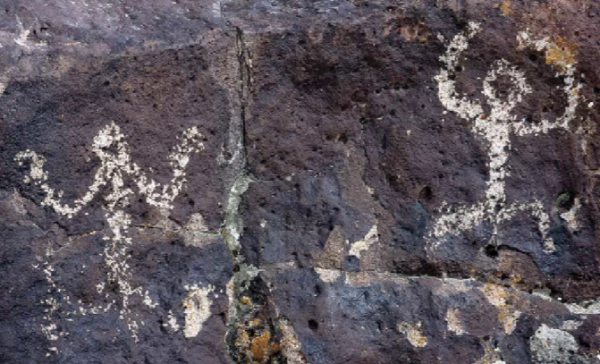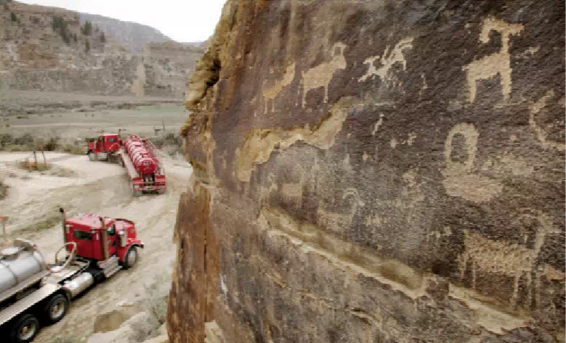The Frantic Race to Save Rock Art Finally Brings Some Good News

Gang symbols. Racial slurs. Proclamations of love. Depictions of sexual positions.
Claire Dean has seen it all.
Dean, a self-employed conservator who rescues rock art
around the world from vandals, reports that graffiti knows
no bounds. “I have dealt with everything from gang stuff to
‘So-and-so was here,’ ‘Jane loves John.’ ”
says Dean, who is based in Portland, Oregon. “I have dealt
with racial stuff, people copying what’s already there.
People have enhanced things: added skis to figures, very
large phalluses—things you wouldn’t put in print. Others
write their names. It’s everything.”
Rock art, also known as petroglyphs and pictographs, is found all over the globe. Those involved in the race to preserve it are battling both natural and deliberate destruction. “It’s everywhere,” Dean says of rock art, which portrays the history and culture of ancient civilizations. “I don’t think there’s a part of the world where we haven’t found it, apart from Antarctica. There is imagery all around the world.”
Vandalism of rock art also abounds, and reports of deliberate destruction have made the news worldwide. Stone carvings in Morocco’s High Atlas Mountains were destroyed in October, the Agence France-Presse reported. Salafists, Muslims who adhere to a strict Sunni interpretation of Islam, are believed to be responsible for destroying etchings depicting the sun as pagan divinity. Those images dated back more than 8,000 years. Thieves in eastern California used power-saws and other heavy equipment to gouge from volcanic stone six rock carvings sacred to the American Indian tribes in the area, including the Paiute, Shoshone and Mono. (The area is remote, but open to tourists.) The vandals also damaged dozens of other carvings in an act some archaeologists are calling the worst case of vandalism in that area. The thieves left scars along a 650-foot cliff band, and panels as large as 20 inches by 40 inches by 6 inches were excavated. Some rock slabs were sawed off 15 feet above ground. The damaged rocks are part of the Volcanic Tablelands, where carvings of hunters, sheep, lizards and deer have stood for 3,500 years. This vast act of vandalism was discovered October 31.
Rock art is a metaphorical footprint of our history,” says Lyle Balenquah, Hopi, who works as an independent archaeologist in Arizona. “Most tribes don’t have a written history, like in the English language. Our culturally significant values and beliefs are contained in visible metaphors, in rock art. They are tangible pieces of our history, literally written in stone.”
Petroglyphs are symbols or pictures carved into stone, the outer layer of stone removed to expose a lighter surface. Pictographs are painted on stone surfaces and generally are more fragile than petroglyphs. From Chauvet Cave in France, which houses some of the world’s oldest known rock art, to remote canyons in the Southwest United States, to the Sahara Desert in Niger where two life-sized giraffes are carved on a rock outcropping, rock art is the elaborate story of the human race.
The oldest evidence of human civilization is in Africa, where scientists believe life began. Modern humans left Africa between 90,000 and 75,000 years ago and spread around the globe, leaving their histories etched in stone. “The journey of mankind began at the diaspora from Africa,” says Peter Robinson, editor of the Bradshaw Foundation, a Geneva-based online educational resource that documents rock art and advocates protecting sites. “We’re one big family,” he adds. “As we traveled across the world, we were dancing and singing and painting as we went.”
Art styles, motifs and themes are similar, regardless of where rock art is found, Robinson says. The Bradshaw Foundation, which publishes interviews, photos and maps online, strives to put each new discovery in context. “It’s not art for art’s sake,” he explains. “It’s mixing an art museum with a cathedral or mosque. In Europe, rock art represents an overall belief system, which persisted with little change for 20,000 years. That is a very long time, so it must have been important.”
Regardless of significance or location, rock art constantly is being vandalized, says Robinson, who believes ignorance and vandalism go hand in hand. “It’s underprotected and undervalued,” he says of rock art.
The Bradshaw Foundation advocates documentation and protection of significant rock art collections as World Heritage sites through the United Nations Educational, Scientific and Cultural Organization (UNESCO).
Protected sites include Easter Island, Stonehenge and the pyramids of Egypt. Rock art is no less important, Robinson argues. “Rock art is a vast natural gallery, 40,000 years of expression,” he said. “Because it’s on every continent, it represents the greatest art museum on the planet.”
Because rock art is continually being discovered around the globe, the Bradshaw Foundation is constantly updating its database, Robinson says. The foundation also documents all reports of vandalism to known sites. That includes the two carved giraffes in Niger. The giraffes, the larger of which is taller than 18 feet, are etched on a rocky outcrop in a remote area along the trans-Siberian caravan trade route. The carvings, discovered in 1987, likely were made by the Tuareg, nomadic inhabitants of Northern Africa who used the route for more than two millennia.
Yet as the site gained in popularity—and despite the remote location—vandals began targeting the art. The giraffes were damaged with graffiti and fragments were chipped off and stolen.
The widespread problem of vandalism leads some caretakers to question whether the sites should be open to the public. Common acts of vandalism include scratching on top of or near the images, spray painting or cutting away pieces and removing them from the site. “The best way to preserve sites is to not let people see them,” says Dianne Souder, chief of interpretation and outreach for New Mexico’s Petroglyph National Monument. “But if you’re trying to teach people, you have that challenge.”
When it comes to national parks or World Heritage sites, caretakers often operate with the philosophy that the more educated the visitors are, the less damage is done. Fifty-one of the 398 national parks in the U.S. include rock art. The majority of rock images outside of parks, however, are not protected by rangers or government officials—the more remote sites on public or private land sometimes are overseen only by volunteer stewards.
Petroglyph National Monument, which covers 7,200 acres, boasts more than 23,000 petroglyphs and another 350 unique archaeological sites. The sites were inhabited by American Indians 300 to 700 years ago.
Souder said the monument has had several thousands of incidents of vandalism since it was established in 1990. Destruction ranges from bullet holes, scratching on the images and evidence that people chipped away entire pieces of rock.
Although intentional destruction does occur, it is a rarity, says Dean, who believes most vandalism happens when people fail to understand the significance of rock art. “In some cases, it’s done wantonly, deliberately,” she says. “I think it’s very rare that people destroy things on purpose.”
Dean, who also works with development companies to complete archaeological assessments before construction begins, believes people more often destroy sacred or cultural sites to remove roadblocks to building. “It’s deliberate destruction, not vandalism,” she says.
The damage almost always is irreversible, says Dean, who works with agencies worldwide to assess damage and determine the best ways to repair or minimize it. “It’s very, very rare that you can reverse the damage,” she said. “If someone carves their name into it, you lose that rock.”
Measures can be taken to mitigate the visual effects, however, Dean says. If vandals used paint to desecrate a site, Dean usually can erase about 98 percent of the damage. “Rock is porous,” she says, “so most paints and inks that are liquid soak in. It’s like writing on a piece of paper. It could be directly on top of or next to a petroglyph or pictogram. It’s rare that we can get it all out.”
Searching for Solutions
Those fighting the battle against vandalism believe they are
winning. “The key to all of this is education,” says Alan
Garfinkel-Gold, an archaeologist for AECOM, a
California-based firm that does impact assessment for
developers, adding that rock art is significant to
understanding the history of the human race. But it is even
more important to Natives who celebrate the images carved by
ancestors. “Often these are religious icons or shrines,” he
says. “They tell a story that is ideologically or culturally
significant.”
From the Native perspective, destruction of rock art is losing the only written history that exists, Balenquah says. “For the tribe, it’s our ability to interpret our past. We don’t have a language, so to speak. [Rock art] serves as visual clues to our ancestors who inhabited a certain region.… When it is vandalized, we lose the opportunity to see where we came from, where we’re going and the opportunity to educate non-Native people about who we are.”
Those who study the images understand that, other than the tens of thousands of years that have past, people today are not so different from those that went before. “Everyone wants to live, be healthy, have a family, protect themselves, live a long life,” Garfinkel-Gold says. “All of this is on the rocks and you see it. We’re not so different. We’re the same people over centuries, millennia.”
Those connections over the years are one of the things lost when rock art is destroyed, Dean says. “If you don’t know what has come before you, it is hard to put yourself in context, in current time. If I try to imagine a place without signs of history, it’s like something floating in an ocean, with no roots. [Rock art] is irreplaceable. Once they’re gone, they’re gone.”
Read more at http://indiancountrytodaymedianetwork.com/2013/02/07/frantic-race-save-rock-art-finally-brings-some-good-news-147498

